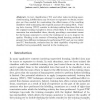Free Online Productivity Tools
i2Speak
i2Symbol
i2OCR
iTex2Img
iWeb2Print
iWeb2Shot
i2Type
iPdf2Split
iPdf2Merge
i2Bopomofo
i2Arabic
i2Style
i2Image
i2PDF
iLatex2Rtf
Sci2ools
98
Voted
ICTIR
2009
Springer
2009
Springer
Training Data Cleaning for Text Classification
Abstract. In text classification (TC) and other tasks involving supervised learning, labelled data may be scarce or expensive to obtain; strategies are thus needed for maximizing the effectiveness of the resulting classifiers while minimizing the required amount of training effort. Training data cleaning (TDC) consists in devising ranking functions that sort the original training examples in terms of how likely it is that the human annotator has misclassified them, thereby providing a convenient means for the human annotator to revise the training set so as to improve its quality. Working in the context of boosting-based learning methods we present three different techniques for performing TDC and, on two widely used TC benchmarks, evaluate them by their capability of spotting misclassified texts purposefully inserted in the training set.
Related Content
| Added | 19 Feb 2011 |
| Updated | 19 Feb 2011 |
| Type | Journal |
| Year | 2009 |
| Where | ICTIR |
| Authors | Andrea Esuli, Fabrizio Sebastiani |
Comments (0)

